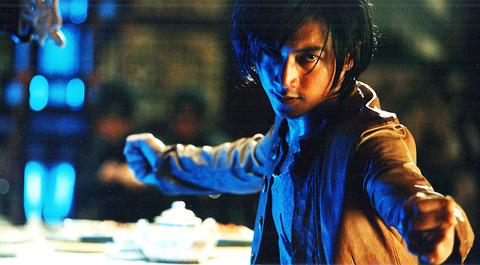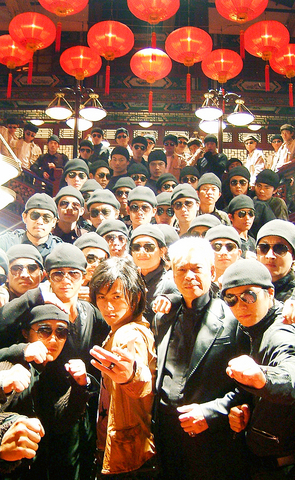Audiences have seen fighters in Hong Kong kung fu movies flash lightning quick moves and soar unimaginable heights. They've seen Jackie Chan's (成龍) improvisational, comic sparring.
In director Wilson Yip's (葉偉信) Dragon Tiger Gate (龍虎門), they are treated to a colorful flurry of action that blends futuristic backdrops, video game-like sets and garish costumes in a new aesthetic scheme for local action cinema.
Based on the Hong Kong comic book by the same name, Dragon follows two estranged brothers, Tiger Wong (Nicholas Tse 謝霆鋒) and Dragon Wong (Donnie Yen 甄子丹), who join fists to defeat an evil lord who tries to destroy their family's kung fu academy.

PHOTOS: AP
Cartoon characters brought to life by live actors carry the risk of coming off as phony. Hollywood can minimize that danger with lavish set and production design.
Director Yip didn't have the luxury of a bottomless budget. Instead, he succeeds by carefully controlling the film's look and sticking to a simple, straightforward plot.
The film, set in Hong Kong, is shot almost exclusively on compact, elegant sets mixed with beautiful illustrations of a beefed up skyline that give a futuristic feel. When Yip shoots on location, he chooses sites that mesh with the surreal plot, such as buildings with commanding views of the city.

The cast is tastefully made up and dressed with disheveled eye-covering dyed hair, snugly fit leather, denim jackets and brightly colored shirts, partly thanks to style consultant William Chang, the famed production designer behind the moody look of art-house director Wong Kar-wai's (王家衛) films.
Yip doesn't try to recreate the comic book in real life. He injects pockets of live action into it. The result is more of an animation than a full-fledged action film.
The movie retains the feel of a comic, which justifies its simplistic plot of good versus evil and cheesy childhood flashbacks.
On the Net: www.dragontigergatemovie.com.

The canonical shot of an East Asian city is a night skyline studded with towering apartment and office buildings, bright with neon and plastic signage, a landscape of energy and modernity. Another classic image is the same city seen from above, in which identical apartment towers march across the city, spilling out over nearby geography, like stylized soldiers colonizing new territory in a board game. Densely populated dynamic conurbations of money, technological innovation and convenience, it is hard to see the cities of East Asia as what they truly are: necropolises. Why is this? The East Asian development model, with

June 16 to June 22 The following flyer appeared on the streets of Hsinchu on June 12, 1895: “Taipei has already fallen to the Japanese barbarians, who have brought great misery to our land and people. We heard that the Japanese occupiers will tax our gardens, our houses, our bodies, and even our chickens, dogs, cows and pigs. They wear their hair wild, carve their teeth, tattoo their foreheads, wear strange clothes and speak a strange language. How can we be ruled by such people?” Posted by civilian militia leader Wu Tang-hsing (吳湯興), it was a call to arms to retake

This is a deeply unsettling period in Taiwan. Uncertainties are everywhere while everyone waits for a small army of other shoes to drop on nearly every front. During challenging times, interesting political changes can happen, yet all three major political parties are beset with scandals, strife and self-inflicted wounds. As the ruling party, the Democratic Progressive Party (DPP) is held accountable for not only the challenges to the party, but also the nation. Taiwan is geopolitically and economically under threat. Domestically, the administration is under siege by the opposition-controlled legislature and growing discontent with what opponents characterize as arrogant, autocratic

Desperate dads meet in car parks to exchange packets; exhausted parents slip it into their kids’ drinks; families wait months for prescriptions buy it “off label.” But is it worth the risk? “The first time I gave him a gummy, I thought, ‘Oh my God, have I killed him?’ He just passed out in front of the TV. That never happens.” Jen remembers giving her son, David, six, melatonin to help him sleep. She got them from a friend, a pediatrician who gave them to her own child. “It was sort of hilarious. She had half a tub of gummies,